(01国陶)氧化钇稳定的氧化锆流延浆料的流变性能,生料带密度,烧成密度之间的关系
氧化钇稳定氧化锆

氧化钇稳定氧化锆
1 氧化钇稳定氧化锆的概念
氧化钇稳定氧化锆是指采用一种氧化钇化学有机物–加入到氧化锆中,在钇降解产生的少量氢氧化钙和氢氧化氢保护氧化锆不受氧化降解物的攻击。
这种技术目前已经在玻璃陶瓷、耐热材料、无隔热材料等领域得到了广泛的应用。
2 氧化钇稳定氧化锆的优点
(1)抗热稳定性好:由于氧化钇在气化反应时会分解氧化锆表面的氧化物,形成一层钇液滴,从而抵挡氧化作用,不容易发生化学变化,使氧化锆的热稳定性得到进一步的改善。
(2)耐腐蚀性高:氧化钇的添加会使氧化锆表面形成一层钇氧化物,这一层可有效地抑制氧化锆受到其它氧化物和有机物质的攻击,从而提高其耐腐蚀性能。
(3)抗渗性好:氧化钇添加后氧化锆表面形成了一层与渗透剂相抗,能有效防止渗透剂渗入内部,使氧化锆具有良好的抗渗性能。
3 氧化钇稳定氧化锆的应用
氧化钇稳定氧化锆具有优良的热稳定性、耐腐蚀性和抗渗性,可广泛用于制造高温陶瓷、耐热材料、航空复合材料、绝缘材料等。
例如,用于制造火箭结构和陶瓷发动机系统,可以耐受超高温的要求;
用于制造绝缘材料和航空复合材料,能够提高循环耐热性能、劣化率和耐腐蚀性能。
4 氧化钇稳定氧化锆的发展前景
氧化钇稳定氧化锆作为一种高性能抗热、耐腐蚀以及抗渗材料,已经在包括火箭结构、高温陶瓷、耐热材料、航空复合材料、绝缘材料等系统中得到了广泛的应用。
随着材料科学技术的不断发展,氧化钇稳定氧化锆将有望朝着更适用于低能耗、绿色材料和经济材料的方向发展。
未来,氧化钇稳定氧化锆将得到更广泛的应用,为人们提供更多更多实用的高性能陶瓷材料。
氧化钇和氧化锆在烧结陶瓷中的作用

氧化钇和氧化锆在烧结陶瓷中的作用
以氧化钇和氧化锆在烧结陶瓷中的作用为题,我们来探讨一下它们在制备烧结陶瓷中的重要作用。
烧结陶瓷是一种重要的陶瓷制备方法,通过将粉末材料在高温下烧结成坚硬的陶瓷材料。
而氧化钇和氧化锆是烧结陶瓷中常用的添加剂,它们在陶瓷制备中起到了重要的作用。
氧化钇在烧结陶瓷中的作用主要表现在增强材料的力学性能和改善材料的烧结性能方面。
氧化钇具有良好的烧结活性,可以在较低的烧结温度下实现高密度的陶瓷制备。
此外,氧化钇还可以减少陶瓷材料的晶粒尺寸,提高材料的力学性能,如硬度、抗压强度等。
因此,氧化钇在烧结陶瓷中被广泛应用于制备高硬度、高强度的陶瓷材料,如氧化锆陶瓷等。
氧化锆在烧结陶瓷中的作用主要表现在增强材料的力学性能和改善材料的导电性能方面。
氧化锆具有良好的导电性和机械强度,可以提高陶瓷材料的导电性能和力学性能。
在烧结陶瓷中添加适量的氧化锆可以有效地提高材料的导电性能,使陶瓷材料具有良好的电导率和导电稳定性。
此外,氧化锆还可以通过控制晶粒生长和晶界结构,改善材料的力学性能,如硬度、韧性等。
因此,氧化锆在烧结陶瓷中广泛应用于制备导电陶瓷、电子陶瓷等。
氧化钇和氧化锆在烧结陶瓷中起到了重要的作用。
氧化钇可以提高
烧结陶瓷的烧结性能和力学性能,而氧化锆可以提高烧结陶瓷的导电性能和力学性能。
因此,它们在陶瓷制备中被广泛应用于制备高性能陶瓷材料。
随着科技的不断发展,氧化钇和氧化锆在烧结陶瓷中的应用也将不断扩展,为陶瓷材料的制备和应用提供更多的可能性。
钇稳定氧化锆密度

钇稳定氧化锆(Yttria-stabilized zirconia, YSZ)的密度大约为6.0g/cm³。
钇稳定氧化锆是一种重要的陶瓷材料,通过添加氧化钇(Y₂O₃)来改变二氧化锆(ZrO₂)的相变温度范围,从而在室温下获得稳定的立方晶体或四方晶体结构。
这种材料具有高强度、高韧性、优良的耐磨性和耐腐蚀性,因此被广泛应用于各种工业领域,如制造固体氧化物燃料电池(SOFC)、刀具、耐磨零件、生物医用材料等。
钇稳定氧化锆的密度是其物理性质之一,对于设计和制造过程中的材料选择和工艺优化至关重要。
例如,在制作氧化锆珠时,不同种类的氧化锆珠具有不同的密度和堆积密度,这些特性会影响其在研磨和其他工业过程中的应用效果。
了解钇稳定氧化锆的密度有助于工程师和研究人员在材料科学和工程应用中做出更合适的决策。
氧化锆陶瓷 钇稳定氧化锆
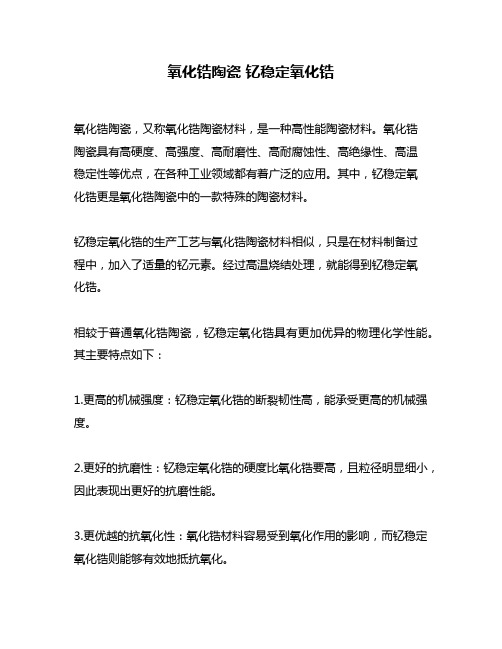
氧化锆陶瓷钇稳定氧化锆氧化锆陶瓷,又称氧化锆陶瓷材料,是一种高性能陶瓷材料。
氧化锆陶瓷具有高硬度、高强度、高耐磨性、高耐腐蚀性、高绝缘性、高温稳定性等优点,在各种工业领域都有着广泛的应用。
其中,钇稳定氧化锆更是氧化锆陶瓷中的一款特殊的陶瓷材料。
钇稳定氧化锆的生产工艺与氧化锆陶瓷材料相似,只是在材料制备过程中,加入了适量的钇元素。
经过高温烧结处理,就能得到钇稳定氧化锆。
相较于普通氧化锆陶瓷,钇稳定氧化锆具有更加优异的物理化学性能。
其主要特点如下:1.更高的机械强度:钇稳定氧化锆的断裂韧性高,能承受更高的机械强度。
2.更好的抗磨性:钇稳定氧化锆的硬度比氧化锆要高,且粒径明显细小,因此表现出更好的抗磨性能。
3.更优越的抗氧化性:氧化锆材料容易受到氧化作用的影响,而钇稳定氧化锆则能够有效地抵抗氧化。
4.更高的耐腐蚀性:钇稳定氧化锆不仅具有普通氧化锆的优良耐腐蚀性能,还具有更好的对水和酸碱性溶液的抗腐蚀性。
5.更佳的电气性能:钇稳定氧化锆不仅具有库仑摩擦系数低、介电强度高、体积电阻率大等电气性能,还具有良好的电子放射能力,被广泛用于医疗领域。
由于其卓越的物理化学性能,钇稳定氧化锆在工业领域的应用前景十分广阔。
例如,钇稳定氧化锆可以用于制造高温炉具、陶瓷转子、送气管道、耐腐蚀泵、医疗器械等产品。
此外,钇稳定氧化锆还可以用于涂层、薄膜等功能性表面处理中。
总之,钇稳定氧化锆作为氧化锆陶瓷材料的一种,具有高硬度、高强度、高耐磨性、高耐腐蚀性、高绝缘性、高温稳定性、电气性能等诸多优点,被广泛应用于工业领域。
同时,由于其优越的性能,在今后的发展中也有着广阔的应用前景。
氧化锆陶瓷 钇稳定氧化锆

氧化锆陶瓷钇稳定氧化锆钇稳定氧化锆(Yttria-Stabilized Zirconia,YSZ)是一种重要的氧化锆陶瓷材料。
它由氧化锆(ZrO2)和钇氧化物(Y2O3)按一定比例混合制备而成。
氧化锆陶瓷具有很高的熔点、硬度和化学稳定性,而钇稳定氧化锆则在这些性质的基础上还具有更好的稳定性和导电性能。
钇稳定氧化锆的稳定性来源于钇氧化物的引入。
钇氧化物在氧化锆晶格中形成固溶体,使晶格结构更稳定。
这种稳定性使得钇稳定氧化锆具有较高的抗热震性能和热循环稳定性,能够在高温下长时间使用而不发生晶格破坏。
此外,钇稳定氧化锆还具有优异的化学稳定性,能够耐受强酸、强碱等腐蚀介质的侵蚀。
钇稳定氧化锆的导电性能使其在固体氧化物燃料电池(Solid Oxide Fuel Cell,SOFC)等高温电化学器件中得到广泛应用。
由于其晶格中的钇离子部分取代了氧化锆晶格的氧离子,导致氧离子缺陷的形成。
这种氧离子缺陷会导致氧离子在晶体中的迁移,从而产生离子导电性。
钇稳定氧化锆的高离子导电性使得其成为固体氧化物燃料电池中的电解质材料,能够在高温下将化学能转化为电能。
除了在高温电化学器件中的应用外,钇稳定氧化锆还广泛用于热障涂层、传感器、陶瓷刀具等领域。
其高熔点和热稳定性使其成为热障涂层材料的理想选择,能够在高温环境下提供有效的隔热保护。
在传感器中,钇稳定氧化锆的导电性能能够被用来检测气体成分、温度等参数变化。
此外,钇稳定氧化锆的高硬度和耐磨性使其成为陶瓷刀具的重要原料,能够在切割、磨削等应用中提供优异的切割效果和耐用性。
钇稳定氧化锆的制备方法有多种,常见的包括固相烧结法、溶胶-凝胶法、等离子体喷涂法等。
其中,固相烧结法是最常用的制备方法之一。
这种方法首先将氧化锆和钇氧化物粉体按一定比例混合,然后通过高温烧结使粉体颗粒结合成致密块体。
溶胶-凝胶法则是通过溶胶-凝胶反应制备钇稳定氧化锆。
这种方法可以得到纯度较高、孔隙度较低的材料。
等离子体喷涂法则是将粉体材料通过等离子体喷涂技术喷涂到基底上,形成涂层。
烧结温度对钇部分稳定氧化锆陶瓷性能研究
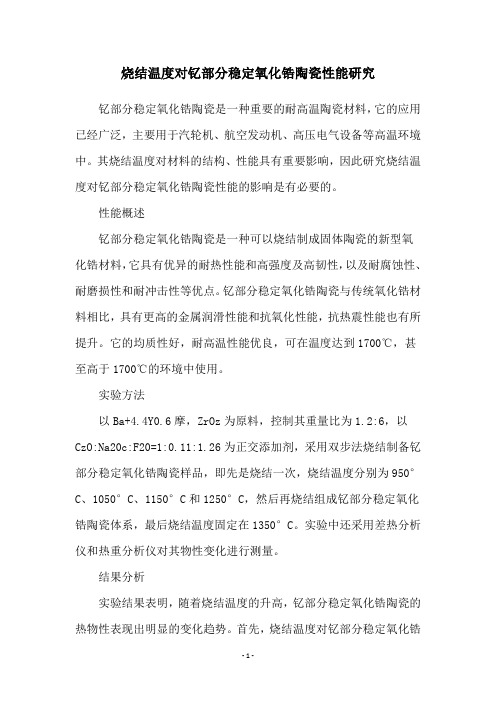
烧结温度对钇部分稳定氧化锆陶瓷性能研究钇部分稳定氧化锆陶瓷是一种重要的耐高温陶瓷材料,它的应用已经广泛,主要用于汽轮机、航空发动机、高压电气设备等高温环境中。
其烧结温度对材料的结构、性能具有重要影响,因此研究烧结温度对钇部分稳定氧化锆陶瓷性能的影响是有必要的。
性能概述钇部分稳定氧化锆陶瓷是一种可以烧结制成固体陶瓷的新型氧化锆材料,它具有优异的耐热性能和高强度及高韧性,以及耐腐蚀性、耐磨损性和耐冲击性等优点。
钇部分稳定氧化锆陶瓷与传统氧化锆材料相比,具有更高的金属润滑性能和抗氧化性能,抗热震性能也有所提升。
它的均质性好,耐高温性能优良,可在温度达到1700℃,甚至高于1700℃的环境中使用。
实验方法以Ba+4.4Y0.6摩,ZrOz为原料,控制其重量比为1.2:6,以CzO:Na20c:F20=1:0.11:1.26为正交添加剂,采用双步法烧结制备钇部分稳定氧化锆陶瓷样品,即先是烧结一次,烧结温度分别为950°C、1050°C、1150°C和1250°C,然后再烧结组成钇部分稳定氧化锆陶瓷体系,最后烧结温度固定在1350°C。
实验中还采用差热分析仪和热重分析仪对其物性变化进行测量。
结果分析实验结果表明,随着烧结温度的升高,钇部分稳定氧化锆陶瓷的热物性表现出明显的变化趋势。
首先,烧结温度对钇部分稳定氧化锆陶瓷的热膨胀系数和热导率有一定的影响。
随着温度的升高,其热导率先呈下降趋势,但在1050°C以后s呈上升的趋势,而热膨胀系数随着温度的提高即呈增加趋势又呈减小趋势。
其次,烧结温度对钇部分稳定氧化锆陶瓷的抗氧化性、耐磨损性以及抗热震性也有一定的影响。
结果表明,烧结温度对抗氧化性和耐磨损性的影响显著,其在1050°C时达到最佳值,而抗热震性则随着温度的增加而提高。
结论研究表明,烧结温度对钇部分稳定氧化锆陶瓷性能有重要影响。
特别是在1050°C时,其表现出的性能最佳,因此可以说它在这温度下得到了最佳烧结状态。
烧结温度对钇部分稳定氧化锆陶瓷性能研究

烧结温度对钇部分稳定氧化锆陶瓷性能研究近年来,随着材料科学的发展,高性能陶瓷材料的应用越来越广泛。
而稳定氧化锆(YSZ)陶瓷又是其中重要的一类,它具有抗氧化性好、耐热性能好、强度高等特征。
然而,由于受到制备工艺的限制,它的性能比起理想性能还有一定的差距。
因此,怎样提高制备工艺乃至陶瓷材料性能一直是目前研究人员所关注的重要课题之一。
在尖端研究领域,最近研究发现,钇部分稳定氧化锆陶瓷(YSZ)的烧结温度对于该材料的物理和化学性能有重要的影响。
因此,本研究的目的是研究钇部分稳定氧化锆陶瓷(YSZ)的烧结温度对其性能的影响。
首先,本文进行了钇部分稳定氧化锆(YSZ)的烧结制备工艺,采用了普通的烧结方式,采用了紫外可见光谱分析仪(UV-Vis)对制备的陶瓷材料进行分析。
结果发现:随着烧结温度的提高,钇部分稳定氧化锆(YSZ)陶瓷中的吸收光谱峰强度增加,表明烧结温度的提高有助于促进YSZ陶瓷的成核。
其次,本研究采用X射线衍射(XRD)和扫描电子显微镜(SEM)进行结构分析。
XRD结果表明,随着烧结温度的提高,YSZ陶瓷的相组成及晶体尺寸均有明显的变化,表明YSZ陶瓷的晶粒尺寸和晶相组成随着烧结温度的提高而发生改变。
SEM分析结果进一步表明,随着烧结温度的提高,YSZ陶瓷的表面形貌也发生明显的改变。
最后,本研究采用比表面积(BET)和拉曼分析(Raman)的方法测量钇部分稳定氧化锆(YSZ)陶瓷的微观特性,结果显示,随着烧结温度的提高,YSZ陶瓷的比表面积和拉曼光谱峰的强度也明显变化。
综上所述,本研究研究了钇部分稳定氧化锆(YSZ)陶瓷的烧结温度对其性能的影响。
实验结果表明,烧结温度对YSZ陶瓷的物理和化学性能有重要的影响,其中包括晶体结构、表面形貌、比表面积和拉曼光谱等。
本研究为提高YSZ陶瓷材料性能提供了有效的参考,为探索YSZ陶瓷性能提供了可行的思路。
氧化钇稳定氧化锆配方

氧化钇稳定氧化锆配方氧化钇稳定氧化锆配方是一种常见的陶瓷材料配方,具有广泛的应用价值。
在这篇文章中,我将深入探讨氧化钇稳定氧化锆配方的多个方面,从基本概念到应用领域,为您提供有关这一主题的全面理解。
首先,让我们了解一下氧化钇和氧化锆是什么以及为什么将它们配方稳定。
氧化钇和氧化锆都是化学元素氧化物,分别由钇和锆元素和氧元素组成。
氧化锆在高温下具有优异的化学稳定性和热稳定性,并具有良好的机械性能和耐磨性能,因此在许多领域被广泛应用,例如陶瓷材料、医疗器械和电子设备等。
为了提高氧化锆的性能,可以将其与氧化钇配方稳定。
氧化钇的加入可以防止氧化锆晶体的相变,从而提高其晶格结构的稳定性。
通过调整氧化钇和氧化锆的摩尔比例,可以控制晶体的形貌和结构,从而使氧化钇稳定氧化锆配方具有更好的物理和化学性能。
在陶瓷材料领域,氧化钇稳定氧化锆配方常被用于制备高性能的结构陶瓷。
由于氧化锆具有优良的机械性能和抗磨性能,氧化钇稳定氧化锆配方的陶瓷制品可以应用于高温环境下的结构零件和耐磨材料。
此外,氧化钇稳定氧化锆配方也在医疗器械领域发挥着重要作用。
氧化锆具有生物惰性和良好的生物相容性,因此氧化钇稳定氧化锆配方的材料常被用于制备人工关节、牙科种植体和骨修复材料等。
它们的优异性能使得医疗器械更加耐用和可靠。
除了陶瓷材料和医疗器械领域,氧化钇稳定氧化锆配方还被广泛应用于电子设备。
由于氧化锆具有优异的介电性能和电导率,氧化钇稳定氧化锆配方的材料常被用于制备电容器、传感器和固态电解质等电子器件。
它们的应用推动了电子技术的发展,并在许多现代设备中发挥着重要作用。
综上所述,氧化钇稳定氧化锆配方是一种具有广泛应用价值的材料配方。
通过深入了解其基本概念、应用领域和性能特点,我们可以更好地理解和利用这一配方。
在陶瓷材料、医疗器械和电子设备等领域,氧化钇稳定氧化锆配方的材料为我们提供了高性能和可靠的解决方案,推动了现代科技的发展。
氧化钇稳定氧化锆配方是一种在械领域中广泛应用的材料配方。
氧化钇稳定氧化锆配方
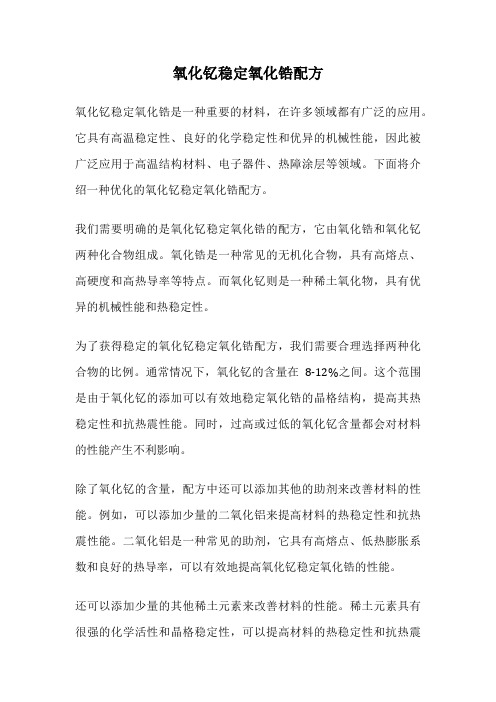
氧化钇稳定氧化锆配方氧化钇稳定氧化锆是一种重要的材料,在许多领域都有广泛的应用。
它具有高温稳定性、良好的化学稳定性和优异的机械性能,因此被广泛应用于高温结构材料、电子器件、热障涂层等领域。
下面将介绍一种优化的氧化钇稳定氧化锆配方。
我们需要明确的是氧化钇稳定氧化锆的配方,它由氧化锆和氧化钇两种化合物组成。
氧化锆是一种常见的无机化合物,具有高熔点、高硬度和高热导率等特点。
而氧化钇则是一种稀土氧化物,具有优异的机械性能和热稳定性。
为了获得稳定的氧化钇稳定氧化锆配方,我们需要合理选择两种化合物的比例。
通常情况下,氧化钇的含量在8-12%之间。
这个范围是由于氧化钇的添加可以有效地稳定氧化锆的晶格结构,提高其热稳定性和抗热震性能。
同时,过高或过低的氧化钇含量都会对材料的性能产生不利影响。
除了氧化钇的含量,配方中还可以添加其他的助剂来改善材料的性能。
例如,可以添加少量的二氧化铝来提高材料的热稳定性和抗热震性能。
二氧化铝是一种常见的助剂,它具有高熔点、低热膨胀系数和良好的热导率,可以有效地提高氧化钇稳定氧化锆的性能。
还可以添加少量的其他稀土元素来改善材料的性能。
稀土元素具有很强的化学活性和晶格稳定性,可以提高材料的热稳定性和抗热震性能。
常用的稀土元素包括镧、铽、镝等。
这些稀土元素可以与氧化钇和氧化锆形成稳定的固溶体,从而提高材料的性能。
在制备氧化钇稳定氧化锆配方时,我们可以采用固相反应或溶胶-凝胶法等不同的制备方法。
固相反应是一种简单的方法,通过将氧化锆和氧化钇混合,然后在高温下进行烧结得到氧化钇稳定氧化锆。
溶胶-凝胶法则是一种复杂的方法,首先将氧化锆和氧化钇溶解在适当的溶剂中,形成溶胶,然后经过凝胶化和热处理得到氧化钇稳定氧化锆。
氧化钇稳定氧化锆是一种重要的材料,在许多高温应用领域具有广泛的应用前景。
通过优化配方和制备方法,可以得到具有优异性能的氧化钇稳定氧化锆材料。
这将为高温结构材料、电子器件、热障涂层等领域的发展提供重要支持。
氧化钇稳定氧化锆原理
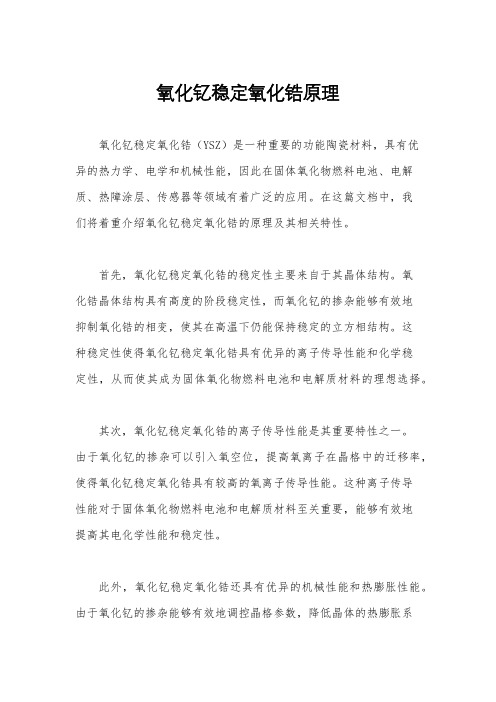
氧化钇稳定氧化锆原理
氧化钇稳定氧化锆(YSZ)是一种重要的功能陶瓷材料,具有优
异的热力学、电学和机械性能,因此在固体氧化物燃料电池、电解质、热障涂层、传感器等领域有着广泛的应用。
在这篇文档中,我
们将着重介绍氧化钇稳定氧化锆的原理及其相关特性。
首先,氧化钇稳定氧化锆的稳定性主要来自于其晶体结构。
氧
化锆晶体结构具有高度的阶段稳定性,而氧化钇的掺杂能够有效地
抑制氧化锆的相变,使其在高温下仍能保持稳定的立方相结构。
这
种稳定性使得氧化钇稳定氧化锆具有优异的离子传导性能和化学稳
定性,从而使其成为固体氧化物燃料电池和电解质材料的理想选择。
其次,氧化钇稳定氧化锆的离子传导性能是其重要特性之一。
由于氧化钇的掺杂可以引入氧空位,提高氧离子在晶格中的迁移率,使得氧化钇稳定氧化锆具有较高的氧离子传导性能。
这种离子传导
性能对于固体氧化物燃料电池和电解质材料至关重要,能够有效地
提高其电化学性能和稳定性。
此外,氧化钇稳定氧化锆还具有优异的机械性能和热膨胀性能。
由于氧化钇的掺杂能够有效地调控晶格参数,降低晶体的热膨胀系
数,使得氧化钇稳定氧化锆在高温下具有良好的热稳定性和热震稳定性。
这种特性使得氧化钇稳定氧化锆广泛应用于热障涂层和高温结构材料中。
总的来说,氧化钇稳定氧化锆作为一种重要的功能陶瓷材料,具有优异的热力学、电学和机械性能,其稳定性、离子传导性能和热膨胀性能使其在固体氧化物燃料电池、电解质、热障涂层、传感器等领域有着广泛的应用前景。
希望通过本文的介绍,能够更好地了解氧化钇稳定氧化锆的原理及其相关特性,为其在材料科学和工程领域的进一步研究和应用提供参考。
钇稳定氧化锆密度

钇稳定氧化锆密度全文共四篇示例,供读者参考第一篇示例:钇稳定氧化锆是一种重要的功能陶瓷材料,具有非常高的密度。
在高温环境下,钇稳定氧化锆能够保持其稳定的结构,并且具有优异的热机械性能和化学稳定性。
本文将从钇稳定氧化锆的基本性质、制备方法和应用领域等方面进行介绍。
一、钇稳定氧化锆的基本性质钇稳定氧化锆是一种固溶体材料,其晶体结构为金红石结构。
这种金红石结构是由正方晶系的ZrO2晶格中的一部分Zr4+离子被Y3+或其他稳定性较好的离子取代形成的。
通过这种对比的掺杂,可以使得晶体内部存在一些不同的点缺陷,从而形成固溶体材料。
钇稳定氧化锆具有非常高的密度,一般在5.68~6.00g/cm3之间。
这种高密度使得钇稳定氧化锆具有很好的抗压性能和抗弹性性能,适用于高温高压环境下的使用。
钇稳定氧化锆的热导率也较高,可以有效地传导热量,防止热应力导致晶体的断裂。
钇稳定氧化锆的制备方法主要有固相反应法、溶胶-凝胶法和水热法等。
固相反应法是最为常用的一种制备方法。
具体步骤包括将氧化锆和稳定氧化钇按一定的比例混合,在一定的温度和时间条件下进行固相反应生成钇稳定氧化锆。
溶胶-凝胶法是通过在溶液中先制备出氧化锆的前驱体,然后在一定的条件下凝胶化成凝胶,再经过煅烧过程制备出钇稳定氧化锆。
水热法则是在高温高压下将氧化锆和稳定氧化钇溶解在水中,形成溶液,经过一定的反应时间后生成钇稳定氧化锆。
由于钇稳定氧化锆具有高密度、稳定性和耐高温性能,因此在多个应用领域中有着广泛的应用。
钇稳定氧化锆被广泛用作高温材料,例如作为热障涂层用于航空航天设备的热防护;用作电子元件的介质材料,例如在固体氧化物燃料电池中作为电解质等。
钇稳定氧化锆还被应用于医疗领域,例如作为人工髋关节或人工牙根等骨科植入材料,由于其优异的生物相容性和力学性能,可以有效地替代传统材料,减轻了患者的痛苦。
钇稳定氧化锆还可以用作光学材料,例如用于激光器的激发材料、光学镜片等。
第二篇示例:钇稳定氧化锆是一种特殊的材料,具有高密度和稳定性的特点。
氧化钇稳定氧化锆原理
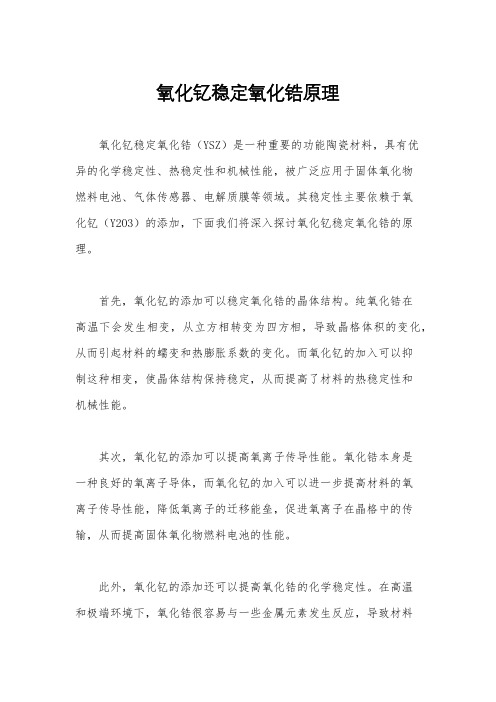
氧化钇稳定氧化锆原理氧化钇稳定氧化锆(YSZ)是一种重要的功能陶瓷材料,具有优异的化学稳定性、热稳定性和机械性能,被广泛应用于固体氧化物燃料电池、气体传感器、电解质膜等领域。
其稳定性主要依赖于氧化钇(Y2O3)的添加,下面我们将深入探讨氧化钇稳定氧化锆的原理。
首先,氧化钇的添加可以稳定氧化锆的晶体结构。
纯氧化锆在高温下会发生相变,从立方相转变为四方相,导致晶格体积的变化,从而引起材料的蠕变和热膨胀系数的变化。
而氧化钇的加入可以抑制这种相变,使晶体结构保持稳定,从而提高了材料的热稳定性和机械性能。
其次,氧化钇的添加可以提高氧离子传导性能。
氧化锆本身是一种良好的氧离子导体,而氧化钇的加入可以进一步提高材料的氧离子传导性能,降低氧离子的迁移能垒,促进氧离子在晶格中的传输,从而提高固体氧化物燃料电池的性能。
此外,氧化钇的添加还可以提高氧化锆的化学稳定性。
在高温和极端环境下,氧化锆很容易与一些金属元素发生反应,导致材料的老化和性能下降。
而氧化钇的加入可以形成稳定的固溶体结构,阻碍金属元素的扩散,减少材料与外界环境的反应,提高了材料的化学稳定性。
综上所述,氧化钇稳定氧化锆的原理主要包括稳定晶体结构、提高氧离子传导性能和提高化学稳定性。
通过合理控制氧化钇的添加量和制备工艺,可以有效改善氧化锆的性能,拓展其在能源、传感器等领域的应用。
总的来说,氧化钇稳定氧化锆的原理是一个复杂而又精妙的过程,需要深入的材料学和化学知识来加以理解和掌握。
随着科学技术的不断发展,相信氧化钇稳定氧化锆这一领域将会有更多的突破和创新,为人类社会的发展做出更大的贡献。
氧化钇稳定氧化锆配方

氧化钇稳定氧化锆配方氧化钇稳定氧化锆配方是一种常用的材料配方,在材料科学和工程领域具有广泛的应用。
本文将介绍氧化钇稳定氧化锆配方的相关知识和应用,以及其在材料工程中的重要性和前景。
一、氧化钇稳定氧化锆配方的基本概念氧化钇稳定氧化锆是一种由氧化锆和氧化钇组成的复合材料。
氧化钇的添加可以显著提高氧化锆的稳定性和性能,使其在高温、高压和强酸碱环境中具有出色的耐磨、耐腐蚀和耐高温性能。
二、氧化钇稳定氧化锆配方的制备方法氧化钇稳定氧化锆配方的制备一般包括原料配比、混合、球磨、成型和烧结等工艺步骤。
首先需要根据所需的性能要求确定氧化锆和氧化钇的配比,然后将两种粉末混合均匀,并通过球磨等方法使其颗粒细化。
接下来,将混合粉末进行成型,常见的成型方法包括压制、注塑和挤出等。
最后,成型体经过烧结处理,形成致密的氧化钇稳定氧化锆材料。
三、氧化钇稳定氧化锆配方的应用领域氧化钇稳定氧化锆具有优异的性能,广泛应用于高温结构材料、陶瓷刀具、电子陶瓷、固体氧化物燃料电池等领域。
在高温结构材料方面,氧化钇稳定氧化锆可以用于制备耐火材料、热障涂层和热电材料等。
在陶瓷刀具方面,氧化钇稳定氧化锆的高硬度和耐磨性使其成为制备高性能刀具的理想材料。
在电子陶瓷方面,氧化钇稳定氧化锆可以用于制备高介电常数和低介质损耗的陶瓷电容器和压电陶瓷。
在固体氧化物燃料电池方面,氧化钇稳定氧化锆常用作电解质材料,具有良好的氧离子导电性能和化学稳定性。
四、氧化钇稳定氧化锆配方的研究进展和前景展望对氧化钇稳定氧化锆配方的研究主要集中在提高其性能、降低制备成本和开发新的应用领域等方面。
有学者通过改变配方、改进制备工艺和引入新的添加剂等方法,提高了氧化钇稳定氧化锆的力学性能、热性能和电学性能。
此外,还有研究表明,通过改变氧化锆和氧化钇的配比、调控晶体结构和界面性能等,可以进一步优化氧化钇稳定氧化锆的性能。
未来,随着科学技术的不断进步和需求的不断增加,氧化钇稳定氧化锆配方有望在更多领域得到应用,为材料工程的发展做出更大的贡献。
钇稳定氧化锆纳米粉体烧结工艺的研究

钇稳定氧化锆纳米粉体烧结工艺的研究任继文;彭蓓;张鸿海;刘胜【期刊名称】《材料工程》【年(卷),期】2009(000)002【摘要】实验研究了钇全稳定氧化锆(8YSZ)纳米粉体的烧结工艺,根据阿基米德原理测瓷体密度,通过测定烧结前后瓷片尺寸获得烧结线收缩率,使用扫描电子显微镜观测样品微观形貌,并探讨了纳米粉体烧结的致密化过程,分析了烧结工艺对致密度和晶粒大小的影响,得到了8YSZ纳米粉体合理的烧结工艺为:采用两步烧结,首先升温到1500℃,升温速率为3℃/min,然后降低温度到1450℃,烧结时间为4h.结果显示,采用该工艺,可以得到相对密度98%,晶粒尺寸小于3μm的性能优异的8YSZ瓷体.研究发现,粉体粒度对烧结性能影响较大,纳米粉体比普通粉体具有较低的开始烧结温度,双粒度混合粉体可以进一步提高其烧结性能.【总页数】5页(P38-42)【作者】任继文;彭蓓;张鸿海;刘胜【作者单位】华中科技大学,微系统中心,武汉430074;华东交通大学,载运工具与装备省部共建教育部重点实验室,南昌330013;华东交通大学,载运工具与装备省部共建教育部重点实验室,南昌330013;华中科技大学,微系统中心,武汉430074;华中科技大学,微系统中心,武汉430074;韦恩州立大学,机械工程系,美国,底特律,MI,48202【正文语种】中文【中图分类】TQ174.758.11【相关文献】1.Al2O3-氮化硼纳米晶包覆的3%氧化钇稳定的r四方氧化锆多晶复合陶瓷粉体的制备 [J], 吴金双;周磊;邢鹤琳;王喆;董超芳;杨瑟飞2.高分散氧化钇稳定纳米氧化锆粉体的制备 [J], 吕彩霞; 曲景奎; 宋静; 孙宏骞; 王雨3.高分散氧化钇稳定纳米氧化锆粉体的制备 [J], 吕彩霞; 曲景奎; 宋静; 孙宏骞; 王雨4.钇稳定氧化锆纳米粉体制备技术研究进展 [J], 王洪升;王贵;张景德;徐廷鸿5.碳吸附沉淀法制备氧化钇稳定氧化锆纳米粉末研究 [J], 郭贵宝;云峰;安胜利因版权原因,仅展示原文概要,查看原文内容请购买。
氧化钇稳定氧化公安密度

氧化钇稳定氧化公安密度
我猜测您想要问的是“氧化钇稳定氧化锆的密度”。
氧化钇稳定氧化锆的密度受氧化钇含量的影响。
实验结果表明,随着氧化钇含量的增加,氧化锆材料的密度逐渐变大。
当钇氧化物含量为5%时,氧化锆的密度达到了6.01g/cm³,在此后的比例变化中密度基本保持不变。
此外,通过电子显微镜观察得知,不同含钇量下晶格常数存在一定的差异,随着含钇量的增加晶格常数逐渐变小。
这表明,氧化钇稳定氧化锆的晶格构型受氧化钇含量的影响,从而影响了其密度性质。
请注意,实际生产中的氧化钇稳定氧化锆的密度可能因制备工艺、原料纯度等因素而有所不同。
因此,如需了解具体产品的密度信息,建议查阅相关产品说明书或咨询相关厂商。
氧化钇稳定的氧化锆陶瓷表面的钛镀层

氧化钇稳定的氧化锆陶瓷表面的钛镀层
丘邑
【期刊名称】《稀土信息》
【年(卷),期】1999(000)007
【摘要】氧化钇稳定的氧化锆(YSZ)陶瓷表面镀一层延性钛能够防止陶瓷脊连接的断裂。
金属镀层可降低由内孔和轴耳承载表面缺陷引起的局部应力,因而能防止裂纹形成。
【总页数】1页(P12-12)
【作者】丘邑
【作者单位】
【正文语种】中文
【中图分类】TQ174
【相关文献】
1.氧化钇稳定四方氧化锆陶瓷的性能老化研究 [J], 陈楷
2.氧化钇稳定氧化锆陶瓷酸性环境下低温时效性能 [J], 谢启飞;王晨;董利民;昝青峰;田杰谟
3.牙科着色氧化钇稳定四方多晶氧化锆陶瓷的结构与性能 [J], 伊元夫;王晨;温宁;林勇钊;田杰谟
4.牙科着色氧化钇稳定四方多晶氧化锆陶瓷的制备及颜色性能 [J], 伊元夫;王晨;田杰谟;刘洪臣;温宁
5.氧化钇稳定的氧化锆陶瓷的相组成和力学及热学性能的关系 [J], 苏坚国
因版权原因,仅展示原文概要,查看原文内容请购买。
- 1、下载文档前请自行甄别文档内容的完整性,平台不提供额外的编辑、内容补充、找答案等附加服务。
- 2、"仅部分预览"的文档,不可在线预览部分如存在完整性等问题,可反馈申请退款(可完整预览的文档不适用该条件!)。
- 3、如文档侵犯您的权益,请联系客服反馈,我们会尽快为您处理(人工客服工作时间:9:00-18:30)。
Correlation between slurry rheology,green density and sintereddensity of tape cast yttria stabilised zirconiaAmit Mukherjee 1,B.Maiti 2,A.Das Sharma,R.N.Basu 3,H.S.Maiti *Electroceramics Division,Central Glass and Ceramic Research Institute,Calcutta 700032,India Received 11July 2000;received in revised form 9August 2000;accepted 19September 2000AbstractAn attempt has been made to investigate the role of dispersant and powder dimension on the slurry rheology and the corre-sponding e ect on green as well as sintered densities of tape cast yttria stabilized zirconia (YSZ).Two commonly used dispersants,viz.menhaden ®sh oil (MFO)and phosphate ester (PE)have been used in conjunction with YSZ powders of di erent particle sizes.It has been found that for this system,PE is a much better dispersant than MFO and the best dispersion is obtained with ®ner YSZ powders.The slurry rheology has a marked e ect on the green as well as subsequent sintered densities of the tapes.#2001Elsevier Science Ltd and Techna S.r.l.All rights reserved.Keywords:A.Tape casting;A.Suspensions;E.Fuel cells,YSZ1.IntroductionYttria stabilized zirconia (YSZ)is the most widely used electrolyte material for oxygen sensor and fuel cell applications.Pure zirconia,ZrO 2,cannot act as a good electrolyte owing to its poor ionic conductivity and phase transformation (monoclinic/tetragonal)on heating associated with a large volume change.Doping of ZrO 2with a small amount (3±10mol%)of a divalent or trivalent oxide can stabilize the cubic ¯uorite phase and,in the process,increases its oxygen vacancy concentration leading to an enhanced ionic conductivity.This makes stabilized zirconia suitable for use as an electrolyte material and yttria (Y 2O 3)is the most commonly used dopant for stabilizing zirconia for the aforesaid applications.The most important criterion in the fabrication of YSZ electrolyte is the production of a highly dense structure,i.e.with no connected porosity (in order to prevent cross ¯ow of gases).Moreover,it should be as thin as possible so that the ohmic loss is minimized.Tape casting is a low cost ceramic fabrication technique that can be employed to produce wide and thin ceramic tapes having precise dimensional tolerances and very smooth surfaces [1].It has also been observed [2]that tape casting leads to a very homogeneous microstructure.It is not surprising,therefore,that many investigators [3±6]have employed this technique to fabricate YSZ electrolyte for di erent applications.In the tape casting process,ceramic powders of su cient ®neness are dispersed in a proper liquid medium followed by the addition of organic binders and plasticizers which increase the mechanical strength and ¯exibility of the green tapes [7,8].However,a homogeneous product of uniform density can be obtained if the starting slurry has a high degree of homogeneity and stability.The alignments and packing of particles in the green tapes dictate the sintering characteristics and the ®nal properties [9,10].Hence,two basic interrelations exist:(1)between the slurry and the green tape,and (2)between the green tape and the sintered product [7].The present work aims to study the correlation between slurry rheology,green den-sity and sintered density of tape cast YSZ sheets.2.Experimental 2.1.Starting materialsIn order to study the e ect of particle size on the slurry rheology and the latter's e ect on the green and0272-8842/01/$20.00#2001Elsevier Science Ltd and Techna S.r.l.All rights reserved.P I I :S 0272-8842(00)00121-8Ceramics International 27(2001)731±739/locate/ceramint*Corresponding author.Fax:+91-033-473-0957.1Present address:Department of Chemistry,College of Engineering and Management,Kolaghat,West Bengal,PIN 721171India.2Present address:Department of Physics,College of Engineering and Mangement,Kolaghat,West Bengal,PIN 721171,India.3Present address:Institut fu r Werksto e und Verfahren der Energie-technik 1,Werksto synthese und Herstellungsverfahren,Forschungs-zentrum Ju lich G mbH,Leo-Brandt-Straûe,D52428,Ju lich,Germany.E-mail address :hsm@cscgcri.ren.nic.in (H.S.Maiti).sintered densities,fully yttria-stabilized zirconia(8mol% yttria)from two di erent sources were used:TZ-8Y, Tosoh Corp.,Japan(designated as T)and8YSZ,ACC Ltd.,India(designated as A).Both the powders are of very high purity(>99.5%).The only di erence is in their particle size distribution;while powder T is very ®ne with a median particle size of only0.18m m,powderA is much coarser with a median particle size of about0.54m m.Suspensions of YSZ were prepared using reagent grade solvents consisting of an azeotropic mixture of methyl ethyl ketone(MEK)and ethanol(EtOH).In order to see the e ect of dispersants on the slurry rheology,green as well as sintered densities of tapes, two most popular commercial dispersants[11,12]were used in the tape casting formulations:phosphate ester, PE(Emphos PS21-A,Witco Chemicals Co.,New York, USA)and Menhaden®sh oil,MFO(Sigma Chemical Co.,St.Louis,MO,USA).For the preparation of tape casting slurry,the binder used was a polyvinyl butyral,PVB(Butvar B98,Mon-santo,St.Louis,MO,USA)and the plasticizer was a mixture of polyethylene glycol,PEG(S.d®ne Chemicals Ltd.,India)and benzyl butyl phthalate,BBP(E.Merck, Germany).2.2.Slurry preparationThe formulations of the slurries are summarised in Table1.The powder was®rst milled in a solvent con-taining a dispersant using ZrO2as milling media for12 h.This step breaks down agglomerates which may be present in the powder.In the second step,the required amounts of binder and plasticizers were added to the suspension and milled for another24h before®nal casting or rheological measurements.2.3.RheologyThe e ectiveness of di erent dispersants(PE and MFO)for both types of YSZ powders(T and A)was estimated from the measurement of slurry viscosity as a function of dispersant concentration.The slurry viscosities were measured using a concentric cylindrical rotational viscometer(VT500,Haake,Germany).A range of shear rates,from40to450sÀ1was employed.2.4.Electrophoretic mobility measurementsFor the measurement of electrophoretic mobility, suspensions containing2wt.%powder were prepared by ball milling the powder together with a solvent and a dispersant using ZrO2milling media for4h.The sus-pensions were centrifuged and the dilute supernatant suspensions containing a small number of particles were collected.These supernatant suspensions were taken in a microelectrophoresis cell(Zetameter3.0,Zetameter Inc.,USA)to note the mobility values by observing the rate of movement of the individual particles under a speci®c electric®eld using a microscope attached with the instrument.2.5.Tape castingPrior to casting,the slurries were vacuum deaired under constant stirring for about2min.This removes any entrapped air in the slurry during ball milling stage. The casting was performed using a laboratory model tape casting unit(Model164,Incetek USA).The slurries were cast on tempered glass plates through a Doctor blade.The cast slurries were allowed to dry overnight at room temperature before they were removed from the glass plate.2.6.Density measurementsFor green density measurements,dried tapes containing plasticizer,binder,dispersant and the ceramic powder were punched into small discs of diameter25±50mm followed by careful measurements of their thickness. The green density of the tapes was then calculated from the weight to volume ratio.In order to measure the sintered density of the tapes, the above mentioned pieces of green tapes were®red in air at di erent temperatures ranging from1450to 1650 C for4h.Both heating and cooling rates wereTable1Formulation particularsPowder Median diameter(m m)Surface area m2/g I:O ratio( )a L b Dispersant Binder( )cÆPlasticizer d*w.r.t binderMFO PEA0.547.4381%39%±0±2%9.32%136%A0.547.4381%51%0±2.5%0±2%9.32%136%T0.1815.7081%45%0±2.5%0±2%9.32%136%a(a)Denotes the inorganic to(inorganic+organic)ratio,i.e.wt.of ZrO2/(wt.of ZrO2+dispersant+binder+plasticizer).b(L)Denotes the powder loading,i.e.wt.of ZrO2/(wt.of ZrO2+solvent+dispersant+binder+plasticizer).c(b)Denotes the wt.%of binder with respect to wt.of the powder.d(*)The wt.ratio of BBP:binder was kept at0.26;whereas,the wt.ratio of PEG:binder was maintained at1.10respectively.732 A.Mukherjee et al./Ceramics International27(2001)731±739controlled very carefully in order to avoid warpage or cracking of the sintered tapes.The densities of the sin-tered discs were then measured by Archimedes'method using water as a medium.2.7.Microstructural studiesThe microstructures of the green as well as the sintered tapes were observed using a scanning electron microscope (Model 30i,Leo,UK).In order to observe the micro-structure of green tapes,small pieces of the samples were exposed to solvent vapours at room temperature for 15±30s to get etched surfaces,which were then observed under the microscope.For sintered samples,after polishing,the surfaces were etched using a mixture of 5%HF and 20%HCl (1:5v/o)for 30±60s.The etched surfaces were then observed under the microscope to see the microstructures.3.Results and discussions3.1.E ect of dispersant on the slurry rheologyWe have selected two dispersants,namely,MFO and PE and their e ectiveness in dispersing powder A with I:O ratio of 81%is shown in Fig.1.It is observed from the ®gure that the viscosity of the tape casting slurry shows a minimum for both the dispersants at a particular dispersant concentration beyond which,the slurry visc-osity increases again.However,the amount of PE (about 1wt.%)required to reach the minimal point is half of that required for MFO (about 2wt.%).It is also evident from Fig.1that the viscosity minimum is much lower and the change much sharper for the slurries containing PE as the dispersant than those containing MFO indicating the former to be a better dispersant.These observations can be explained by considering the mode of action of the two dispersants.It is well known that the dispersion capability of MFO,which is a polyunsaturated ester molecule,is mainly due to steric stabilisation [13,14].It has been shown [15]that during the ball milling stage breakdown of large,porous hard agglomerates takes place.These agglomerates tend to occlude liquid in the interparticle pore channels resulting in a lower quantity of solvent to ¯ow.However,upon breakdown of these hard agglom-erates to primary particles,more solvent is e ectively free to ¯ow resulting in lower viscosity.The role of a dispersant is to keep these primary particles separated from each other thereby preventing their agglomeration due to van der Waals attraction energy.It is evident from Fig.1that MFO is most e ective to maintain the separation of these particles at a concentration of about 2g per 100g of powder resulting in viscosity minimum at that concentration.The increase in viscosity over the optimum dispersant concentration using MFO has been observed for other systems also [11,13].PE (reaction product of phosphoric acid and ethoxylate;ethoxylate molecules contains both a hydrophilic poly-oxyethlene group and lipophillic alkyl group)on the other hand,operates by the electrosteric stabilisation mode [7].It has been proposed [7,16]that in a polar medium like MEK:EtOH,the decrease in viscosity below the optimum concentration of PE may be attributed to the ionization of PE on the particle surfaces to create charged surfaces leading to an electrostatic barrier.At the same time,the linear carbon chain extends into the polar solvent to provide steric stabilisation.It is believed [7]that for highly concentrated suspensions,using dis-persants which shows such a combination of both electro-static and steric mechanisms,the suspension stability will be much more compared to that where only either of the mechanisms operates.It is expected therefore,that the drop in the viscosity of the tape casting slurry utilising PE will be signi®cantly higher than that of MFO containing slurry.However,beyond the optimum concentration,the ionized PE molecules has a tendency to interact with each other [11]so that bridging ¯occu-lation occurs [17]and the slurry viscosity increases sharply.A similar trend in the increase in viscosity of slurries beyond the optimum concentration of PE has also been observed for BaTiO 3based slurries [18].It is well established that the pseudoplasticity of a slurry is dependent on the capability of the particles to align them with increasing shear rates.With increasing particle orientation the resistance to shear decreases,thereby decreasing viscosity [19].The shear thinning behaviour may also be due to particle ¯occulation [20,21].Therefore,it is expected that the pseudoplastic e ect will be lowered when there is low particle ¯occu-lation or when the particle orientation is less in the tape casting slurry.Fig.2represents the shear thinning beha-viour of the tape casting slurries corresponding to two di erent dispersants (PE and MFO)in theformulationsFig.1.Variation of slurry viscosity with dispersant concentration for di erent dispersants.A.Mukherjee et al./Ceramics International 27(2001)731±739733utilising powder A.It should be mentioned here that these measurements were carried out at the optimum dispersion conditions (2wt.%of MFO and 1wt.%of PE in the corresponding formulations respectively).It can be observed from the plot that the viscosity of the slurries utilising MFO is higher than that corresponding to PE throughout the range of shear rates investigated (40to 450s À1).The shear thinning behaviour of the slurries can be monitored by an estimation of the ¯ow index as obtained from the following empirical power law equa-tion [22]: K nIwhere is the shear stress, is the shear rate,K ,a con-sistency factor and n is the pseduplasticity index respec-tively.For pseudoplastic suspensions,the value of n is less than 1and,the greater the divergence from Newtonian behaviour,the lower is its value.Table 2shows the values of the pseudoplasticity index of the above two slurries calculated by Patton's method [23].The values of n clearly demonstrate that with the increase in shear rate,the pseudoplasticity of both the slurries increases (n decreases).It is obvious from Eq.(1)that to maintain a constant change in shear rate,the change in shear stress will be lower at correspondingly higher shear rates.This would naturally imply that the value of n should decrease at high shear rates,as is observed with all the slurries investigated.It can also be seen from Table 2that the total change in the value of n (Án )for the slurry containing PE (A-PE)is greater than that of the slurry containing MFO (A-MFO).For highly concentrated suspensions of tape casting pro-cess,it is expected that even after using proper dispersants in optimum concentrations,the slurries should haveagglomerated particles.Under shear conditions,as a ®rst step,the agglomerates will be broken down into smaller units or as a terminal case to primary particles.These smaller units and individual particles will then subsequently try to orient themselves under shear.As discussed previously,the e ectiveness of MFO as a dispersant is less compared to PE which results inaFig.2.Viscosity vs.shear rate plots of YSZ slurries stabilized with di erent dispersants.Table 2Rheological parameters for the di erent tape-casting slurriesPowder system Loading (L )a Torque (N.Cm)Shear stress (Pa)Shear rate (s À1)Pseudoplasticityindex (n )A/PE390.1230.3640.320.1743.0157.410.970.2768.3195.940.940.44111.32159.800.940.70177.10266.700.901.06268.18444.600.81A/PE 510.1947.9840.320.2666.8857.410.940.42106.4995.940.900.66168.59159.800.901.01256.03266.800.811.42360.12444.600.66A/MFO 510.2051.0040.320.2870.4457.410.910.44110.8195.940.880.68174.18159.800.881.05267.23266.700.831.54391.25444.600.74T/PE 450.2460.8840.320.3384.3957.410.920.51130.4795.940.850.75190.16159.800.851.10280.14266.700.711.54409.12444.600.65aL denotes the powder loading in wt.%percent.734 A.Mukherjee et al./Ceramics International 27(2001)731±739greater degree of agglomeration in A-MFO slurry.Thus, the corresponding resistance of these agglomerates to orient them under shear will be greater.This would automatically imply that pseudoplasticity of MFO slurries will be lower compared to that of PE slurries.The above contention is re¯ected in the total changes of the¯ow index value,Án,which may be as low as0.17for MFO containing slurries and as high as0.28for PE containing slurries.3.2.E ect of particle sizeThe same kind of measurements on slurry rheology (viscosity,pseudoplasticity)were carried out with PE as a dispersant,but taking two kinds of powderÐpowder T of smaller particle size and,powder A of coarser one. Fig.3shows a comparison of the viscosities of the slurries containing powder A and T as a function of PE concentration.It is evident from the®gure that the viscosity of the slurry containing powder T is higher than that containing powder A throughout the range of dispersant concentration used.Similar viscosity depen-dence upon particle size has also been observed by several workers[24,25].Although such higher viscosities in combination with shear thinning behaviour(discussed later)is generally attributed to¯occulation of particles, electrophoretic mobility measurements show the®ner particles(powder T)to have almost threefold higher mobility(1.603m2VÀ1sÀ1)compared to coarser particles (powder A)for which the mobility value is only0.495 m2VÀ1sÀ1.This would imply that the®ner particles are better dispersed in the tape casting slurry.Thus,in order to explain such high viscosities for®ner particles other factors,such as Brownian motion and electroviscous e ect,should be operational in these slurries.These two phenomena are known to become increasingly important with decreasing particle dimensions[25].These e ects will be discussed brie¯y while comparing the pseudo-plasticity e ect of these slurries.It can also be seen from Fig.3that the optimum dis-persant concentration for the viscosity minimum for powder T is higher by around25%.This is expected as with the decrease in particle size there is an increase in surface area of the powders in the composition.This would imply a higher amount of dispersant required to cover the surface area for e ective particle separation [9,26].The change in particle dimension also shows a re¯ection on the shear thinning behaviour of the slurries(Fig.4). It is evident from Fig.4that the nature of the viscosity plot with shear rate for powder T di ers widely from that of powder A.As a rough estimation,the ratio between the terminal viscosities for powder T is1.71 whereas for the powder A the corresponding value is only around1.47.Such higher changes in viscosity with shear for®ner particles has been observed for other systems too[27±32]and the results indicate that the shear thinning behaviour of®ner particles is a combi-nation of the phenomena of Brownian motion and electroviscous e ect[28±32].The electroviscous e ect becomes increasingly important with higher electro-phoretic mobility,higher surface charge density and decrease in particle size respectively.The¯ow index value(n)for the system T/PE,com-pared with the same for A/PE,(Table2)also shows that the slurry corresponding to T/PE is more pseudoplastic. However,the total change in the¯ow index for T/PE is almost the same when compared to A/PE(Án=0.28). Apparently,these results may appear to be contra-dictory.However,considering the powder loading to be much lower in the case of T/PE slurry,the total change in the¯ow index is relatively higher compared to that of A/PE slurry.The powder loading was deliberately kept low in the case of powder T so as to keep itsviscosity Fig.3.Viscosities of YSZ slurries as a function of PE concentration for di erent powders.A.Mukherjee et al./Ceramics International27(2001)731±739735within manageable limits for the casting operation.It is evident,therefore,that in the case of ®ne powders,several factors have a contribution in determining the slurry rheology as discussed above.3.3.Green density of tapesIt is well known that the state of dispersion has an important in¯uence on the green microstructure,which develops during powder consolidation upon evapora-tion of the solvent.Well-dispersed suspensions tend to produce highly dense,homogeneous compacts.Figs.5,6and 7show the variation of green density as a function of the dispersant concentration.While Figs.5and 6is the comparison of the changes that occur while sub-stituting PE by MFO in the tape casting slurry;Figs.6and 7show such variation by replacing powder A with powder T.It is worth mentioning that all the results reported here are taken over a large number of samples involving ®ve di erent batches.It is evident from Fig.5that with variation in MFO concentration,the mean values of green density do not change appreciably ($53%of theoretical value).How-ever,it is more signi®cant to note the values of standard deviation (being an index to measure the uniformity of the tapes)of these green densities with changes in MFO concentration.It is observed from Fig.5that the slurry corresponding to a MFO concentration of 2wt.%per 100g of powder is more homogeneous (as re¯ected from the standard deviation values)compared to other green compacts.Such variation in green density is in line with the viscosity measurements which showed that at this concentration of dispersant the degree of agglomeration is lowest.A somewhat di erent trend is obtained for the slurry containing PE (Fig.6).In this case,with changes in the dispersant concentration the mean grain density shows a gradual rise from a value of $53%(of theoretical value)at zero dispersant concentration to a value of $56%at a dispersant concentration of 1wt.%.Further increase in dispersion concentration showed a negative e ect on the green density.Fig.6also shows that the standard deviation values are lower compared to those for the MFO containing slurries,with a minimum occurring at 1wt.%of ester.Thus,these results re¯ects similar trends as obtained from the rheological measurements which showed PE to be a more e ective dispersant compared to MFO both in terms of maintaining particle separation and its low requirement in the slurry.A similar trend is also observed while changing the powder dimension from A to the ®ner variety T with PE as a dispersant.However,in this case,the meangreenFig.4.Viscosity vs.shear rate plots of slurries prepared with YSZ powders of di erent particlesizes.Fig.5.Density of green tapes as a function of MFO concentration in the corresponding slurry prepared with powder A.736 A.Mukherjee et al./Ceramics International 27(2001)731±739density reaches a maximum ($57%of theoretical value)at a dispersant concentration of 1.25wt.%(Fig.7).Also the standard deviation of these compacts are appreci-ably lower compared to the deviation observed with powder A.These observations are in line with the elec-trophoretic mobility and rheological measurements which showed that powder T produces a more stable suspension compared to powder A under identical conditions.Fig.8shows a representative micrograph of the green tape as obtained from T-PE system.However,by trying to view the microstructure of as obtained green tapes nothing signi®cant was observed.This is primarily due to the binder phase at the surface.However,when these tapes are solvent etched selectively at the surface it opens up windows to view the microstructure of the underlying powders (Fig.8a).A magni®ed look through the etched portion shows the particles are almost homogeneously distributed implying a high packing density with intermittent ®ne pores (Fig.8b).3.4.Sintering of tapesTable 3shows the shrinkage vis-a-vis the sintered density for the tapes obtained from the formulations representing the optimum dispersion conditions.It is observed that the trend in shrinkage is parallel to the densi®cation process and follows the trend T-PE>A-PE>A-MFO.It is well known [33],that the di erences in the green microstructures have a profound e ect on subsequent sintering behaviour;a highly ordered compact sinters to near theoretical density,whereas for suspensions invol-ving ¯ocs,under similar conditions of sintering,the resultant sintered density has a much lower value.Such di erences in sintering are primarily due to the fact that for ¯occulated systems only local densi®cation (of tightly packed particle clusters)occurs,whereas for ordered compacts,due to a large number of nearest neighbour contacts per particle and uniform small pore size,sintering is enhanced.Moreover,rearrangement and di erential microdensi®cation processes,which produce larger pores and lower shrinkage rates are minimized in ordered compacts [34].Representative microstructures of the sintered tapes of A-PE and T-PE are shown in Fig.9.Both the samples show existence of pores although,as expected,the porosity of the sintered substrates corresponding to powder T (Fig.9a)is appreciably lower compared to that of the substrates prepared with powder A (Fig.9b).Moreover,as expected [35],the sintering temperature of the ®ne particles are appreciably lower (1500 C)compared to that of powder A (1650C).Fig.6.Density of green tapes as a function of PE concentration in the corresponding slurry prepared with powderA.Fig.7.Density of green tapes as a function of PE concentration in the corresponding slurry prepared with powder T.A.Mukherjee et al./Ceramics International 27(2001)731±7397374.ConclusionsDetailed investigations were carried out to ®nd out the e ect of the dispersant and powder dimension on the slurry rheology and the corresponding e ect on green as well as sintered densities of cast YSZ tapes.The results of these experiments have revealed that in the present case,phosphate ester is a much more e ective dispersant compared to menhaden ®sh oil as manifested in the corresponding viscosity and ¯ow index values for the suspensions of the powders investigated.Moreover,the results point out that the degree of agglomeration is higher for slurries involving MFO,and the best dispersionwas obtained with ®ner powders in conjunction with PE as the dispersant.It has been shown that the suspension rheology has also a profound e ect on the green density and the subsequent sintered density of the tapes.AcknowledgementsFinancial support from Board of Research in Nuclear Sciences (BRNS),Govt.of India,is gratefully acknowl-edged.One of the authors (BM)acknowledges ®nancial assistance from the EMR Division of CSIR,Govt.ofIndia.Fig.8.Scanning electron micrograph of green tapes.(a)Solvent etched surface and (b)magni®ed view of the same.Table 3Shrinkage and sintered density of YSZ tapes System(sintering temperature)Comparative state of dispersion Degree of agglomeration Green density (%theoretical)Shrinkage (%)Sintered density (%theoretical)T-PE (1500 C)Best Lowest 572796A-PE (1650 C)Better Higher 563094A-MFO (1650 C)PoorHighest533291Fig.9.Scanning electron micrograph of sintered tapes.(a)Prepared with powder T and (b)prepared with powder A.738 A.Mukherjee et al./Ceramics International 27(2001)731±739。
